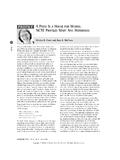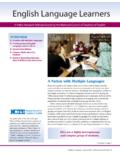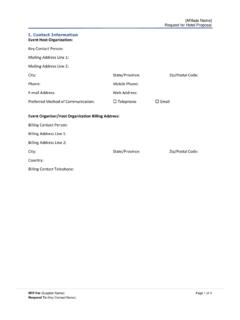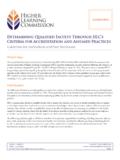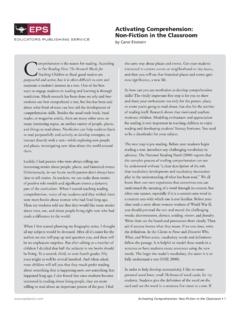Transcription of The Relationship of Disability Rights Laws to Education ...
1 The Relationship of Disability Rights laws to Education Majors and Teachers with Disabilities Conference on English Education Commission for the Preparation of Teachers with Disabilities The National Council of Teachers of English Cynthia A. Bowman, CEE Liaison Katherine Barr, Chair Karen Ford Nancy McCracken Kim McCullum-Clark Paul T. Jaeger, Legal Advisor I. What is a Disability ? Fifty-four million Americans have some form of Disability . Individuals with disabilities are protected from discrimination by three major laws : the Rehabilitation Act, the Individuals with Disabilities Education Act (IDEA), and the Americans with Disabilities Act (ADA).
2 The Rehabilitation Act and the ADA are the most general anti- Disability discrimination laws , protecting individuals with disabilities in virtually all aspects of daily life. Under the definitions of the Rehabilitation Act and the ADA, a Disability is, most commonly, a physical or mental impairment that substantially limits one or more major life activities. A physical or mental impairment is any physiological disorder or condition, cosmetic disfigurement, or anatomical loss affecting any one or more major body systems, such as sensory functioning or neurological functioning, and any mental or psychological disorder. A major life activity is an activity in which an individual engages numerous times, if not constantly, over the course of each day of the individual s life.
3 Major life activities include caring for oneself, performing manual tasks, walking, seeing, hearing, speaking, breathing, learning and working, sitting, standing, lifting, reaching, and engaging in mental or emotional processes such as thinking, concentrating, and interacting with others. A substantial limitation of a major life activity means a person is unable to perform that activity at all or can only perform the activity in severely limited fashion compared to other individuals performing the same activity. The physical and mental impairments that do substantially limit major life activities include a wide range of conditions. Some of the more common physical disabilities include hearing impairments, visual impairments, mobility impairments, multiple sclerosis, muscular dystrophy, chronic fatigue, immune dysfunction syndrome, Crohn s disease, and cardiac problems.
4 Some types of physical impairment can be a Disability or not depending on whether a major life activity is being limited. HIV, AIDS, and AIDS Related Complex can be disabilities, but commonly are not disabilities when treatments prevent the disease from limiting any major life activities. A mental impairment, to be considered a Disability , must be diagnosed by mental health professionals as a condition that constitutes impairment of a major life activity. Many mental health conditions are impairments that do not substantially limit any major life activities. Manic depression, autism, apraxia, organic brain syndrome, and schizophrenia can all be disabilities, but only if the individual with the mental impairment is substantially limited in a major life activity due to the condition.
5 Certain conditions are deemed by the law not to constitute disabilities under any circumstances: homosexuality; bisexuality; transvestitism; transsexualism, pedophilia; exhibitionism; voyeurism; gender identity disorders not resulting from physical impairments; any other sexual behavior disorders; pyromania; compulsive gambling; kleptomania; current alcoholism; obesity; and psychoactive substance use disorders resulting from the current illegal use of drugs. An individual can also be legally defined as disabled if the individual has a record of such impairment or is regarded as having such impairment. The first of these conditions is for individuals who have had an impairment that substantially limited a major life activity, but which no longer does.
6 An example is an individual who has a history of cancer that is cured or in remission. Other individuals who may qualify under this condition include people with a prior history of mental illness, heart disease, or other treatable diseases. The second condition is for individuals who do not have an impairment that significantly limits a major life activity, but they have been mistakenly identified, classified, or treated as if they were disabled. Some examples of this condition include people being mistakenly treated as disabled for being a carrier of the Hepatitis B virus, having asymptotic HIV, or having minor physical ailments such as minor knee or back pains.
7 IDEA, as it deals specifically with the educational Rights of disabled children, protects only children who are educationally disabled. IDEA specifically lists the types of disabilities recognized under that law. The list of the disabilities that are recognized under IDEA are: mental retardation, hearing impairments including deafness, speech or language impairments, visual impairments including blindness, serious emotional disturbance, orthopedic impairments, autism, traumatic brain injury, other health impairments, or specific learning disabilities. II. What are the Rights of Individuals with Disabilities in Teacher Education Programs?
8 Individuals with disabilities who are students in post-secondary programs, including teacher Education programs, are all protected from discrimination by the Rehabilitation Act and the ADA. These laws prohibit colleges from engaging in discrimination in any academic, research, training, physical Education , athletic, or other post-secondary Education program. The laws forbid discrimination in the general treatment of a student with a Disability . The laws specifically state that colleges also cannot discriminate in recruitment, admissions practices and decisions, housing, financial assistance, employment assistance, nonacademic services, physical Education , athletic events, counseling, placement decisions, and social activities and organizations.
9 Students with disabilities at the post-secondary level should be educated, to the maximum extent appropriate, in integrated settings. Schools may not discriminate against students with disabilities in recruitment, application, testing, interviewing, or decision-making. A student with a Disability cannot be denied admission to a school or program unless that Disability prevents the student from successfully performing the goal of the program without unnecessary risk to others. Admissions committees may not hold standard tests taken with accommodations to be of lesser value than standardized tests taken under normal circumstances. A school cannot make use of any test or criterion for admission that has a disproportionate or adverse effect on students with any type of Disability , unless the test or criterion has been demonstrated to be a valid predictor of success in that particular program and no alternate test or criterion with a lesser disproportionate, adverse effect exists.
10 In cases of late diagnosis of a Disability , admission decisions should account for the late diagnosis and time to adapt to treatment in making decisions regarding readmission. A school should not make pre-admission inquiry as to whether an applicant for admission has a Disability but may make post-admission inquiries on a confidential basis to determine if accommodations are needed. A school may not require a person with a Disability to identify the Disability as a requisite for admission, unless the school or program is specifically designed for individuals with disabilities. Also, any school may make a pre-admission inquiry as to Disability if the reason is to redress past discrimination.



